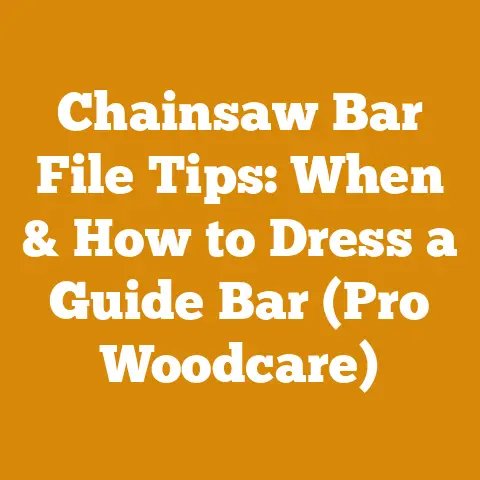How to Get Rid of Carpenter Ants in Trees Naturally (Pro Tips)
How to Get Rid of Carpenter Ants in Trees Naturally (Pro Tips)
I’ve battled carpenter ants in trees more times than I can count. It’s a frustrating problem, but before you reach for harsh chemicals, let’s explore some natural, effective methods. I’m going to walk you through everything I’ve learned over the years, from identifying the problem to implementing solutions that won’t harm your trees or the environment. This guide will cover proactive measures, natural treatments, and even some preventative strategies to keep these wood-boring pests at bay.
Understanding Carpenter Ants and the Threat to Your Trees
Carpenter ants aren’t like termites; they don’t eat wood. Instead, they excavate it to create nests, which can weaken the structural integrity of trees. Recognizing the signs of infestation early is crucial.
Identifying Carpenter Ant Infestations
The key to successful carpenter ant control is early detection. Here are the signs I always look for:
- Sawdust (Frass): This is a telltale sign. It looks like coarse sawdust and is often found near entry points to the nest. I’ve noticed it’s usually a mix of wood shavings, insect parts, and debris.
- Visible Galleries: You might see small holes or slits in the wood where the ants are entering and exiting. These galleries can weaken the tree over time.
- Ant Activity: Observing large black ants crawling on or around the tree, especially at night, is a clear indicator. They are most active during the evening and nighttime hours.
- Hollow Sounds: Tapping on the trunk or branches might reveal hollow areas where the ants have been nesting. I use a rubber mallet for this; it’s gentler on the tree.
Why Trees are Vulnerable
Trees are susceptible to carpenter ant infestations for several reasons:
- Moisture: Carpenter ants are attracted to damp or decaying wood. Areas with poor drainage or fungal growth are prime targets.
- Wounds and Injuries: Open wounds from pruning, storm damage, or animal activity provide easy entry points for the ants. I always seal pruning cuts promptly with tree wound sealant.
- Existing Decay: Trees with existing rot or decay are more vulnerable because the wood is already softened, making it easier for the ants to excavate.
Key Takeaway: Regular inspections are essential. Look for frass, visible galleries, and unusual ant activity. Address any signs of decay or damage promptly.
Proactive Measures: Preventing Infestations Before They Start
Prevention is always better than cure. These are the steps I take to minimize the risk of carpenter ant infestations in my trees:
Maintaining Tree Health
A healthy tree is more resistant to pests and diseases. Here’s what I do:
- Proper Watering: Overwatering can lead to root rot, making the tree more susceptible to infestation. Ensure the soil drains well and avoid standing water around the base of the tree. I use a moisture meter to check the soil before watering.
- Fertilization: Balanced fertilization supports healthy growth and strengthens the tree’s natural defenses. I use a slow-release fertilizer in the spring, following the manufacturer’s instructions.
- Mulching: Mulch helps retain moisture, regulates soil temperature, and suppresses weeds. However, keep mulch away from the tree trunk to prevent moisture buildup and decay. I maintain a mulch-free zone of about 6 inches around the base of the trunk.
Addressing Wounds and Decay
Promptly addressing wounds and decay is crucial to prevent carpenter ants from exploiting these vulnerabilities:
- Pruning: Prune dead, damaged, or diseased branches to improve air circulation and remove potential entry points for pests. Always use clean, sharp pruning tools to minimize damage to the tree.
- Sealing Wounds: Seal pruning cuts and other wounds with a tree wound sealant to protect the exposed wood from decay and infestation. I prefer a sealant that contains fungicide to prevent fungal growth.
- Removing Decaying Wood: Remove any decaying wood from the tree to eliminate potential nesting sites. If the decay is extensive, consult with an arborist to determine the best course of action.
Managing Moisture
Carpenter ants are attracted to damp wood. Here’s how I manage moisture around my trees:
- Improving Drainage: Ensure the soil around the tree drains well. If necessary, amend the soil with organic matter to improve drainage. I sometimes install drainage tiles in particularly wet areas.
- Ventilation: Improve air circulation around the tree to reduce moisture buildup. Prune dense foliage to allow more sunlight and air to reach the trunk and branches.
- Removing Debris: Remove leaf litter, fallen branches, and other debris from around the base of the tree to prevent moisture retention and provide a less inviting environment for carpenter ants.
Key Takeaway: Healthy trees are less susceptible to infestation. Focus on proper watering, fertilization, addressing wounds, and managing moisture to keep your trees strong and resilient.
Natural Treatment Options for Carpenter Ants
When you discover a carpenter ant infestation, you don’t have to immediately reach for harsh chemicals. I’ve found several natural treatments to be effective, especially when applied early.
Boric Acid
Boric acid is a naturally occurring mineral that is toxic to insects. It disrupts their digestive system and can be very effective against carpenter ants.
- How it Works: Carpenter ants ingest the boric acid while grooming or feeding, leading to their demise.
- Application: I mix boric acid with a sweet bait, such as honey or sugar water, to attract the ants. Place the bait near the nest or along ant trails. Be careful to keep it away from pets and children.
- Safety: While boric acid is relatively safe for humans and pets in low concentrations, it can be harmful if ingested in large quantities. Always use it with caution and store it out of reach of children and animals.
Diatomaceous Earth (DE)
Diatomaceous earth is a powder made from the fossilized remains of diatoms, a type of algae. It’s a natural desiccant that dries out insects’ exoskeletons.
- How it Works: DE absorbs the waxy coating on the ants’ exoskeletons, causing them to dehydrate and die.
- Application: I apply a thin layer of DE around the base of the tree, along ant trails, and near any entry points to the nest. Be sure to use food-grade DE, as it is safer for use around plants and animals.
- Effectiveness: DE is most effective when it is dry. Reapply after rain or watering.
Vinegar
Vinegar is a natural acid that can disrupt ant trails and deter them from entering an area.
- How it Works: Vinegar disrupts the scent trails that ants use to navigate, making it difficult for them to find their way back to the nest.
- Application: I mix equal parts vinegar and water in a spray bottle and spray it directly on ant trails, around the base of the tree, and near any entry points.
- Limitations: Vinegar is a temporary solution and needs to be reapplied frequently, especially after rain.
Essential Oils
Certain essential oils have insecticidal properties and can be used to repel or kill carpenter ants.
- Effective Oils: Peppermint, tea tree, and cedarwood oils are known to be effective against ants.
- Application: I mix a few drops of essential oil with water in a spray bottle and spray it on ant trails, around the base of the tree, and near any entry points.
- Safety: Essential oils can be irritating to the skin and eyes. Use caution when applying them and avoid direct contact.
Soapy Water
Soapy water can disrupt the ants’ exoskeletons and suffocate them.
- How it Works: The soap breaks down the waxy coating on the ants’ exoskeletons, causing them to dehydrate and die.
- Application: I mix a few tablespoons of dish soap with water in a spray bottle and spray it directly on the ants and their trails.
- Effectiveness: Soapy water is most effective when applied directly to the ants. It is a temporary solution and needs to be reapplied frequently.
Key Takeaway: Natural treatments can be effective, especially when applied early and consistently. Boric acid, diatomaceous earth, vinegar, essential oils, and soapy water are all viable options.
Finding and Eliminating Nests
The most effective way to get rid of carpenter ants is to locate and eliminate their nests. This can be challenging, but it’s essential for long-term control.
Tracing Ant Trails
Follow ant trails to locate the nest. Carpenter ants often forage for food at night, so this is a good time to observe their activity.
- Observation: Watch where the ants are going and coming from. Look for patterns in their movement.
- Nighttime Activity: Use a flashlight to follow the ants at night. They are most active during the evening and nighttime hours.
- Mapping: Draw a map of the ant trails to help you pinpoint the location of the nest.
Identifying Nesting Sites
Carpenter ants typically nest in damp or decaying wood. Here are some common nesting sites:
- Tree Trunks: Check for hollow areas or soft spots in the trunk.
- Branches: Look for dead or decaying branches that may be harboring a nest.
- Root Systems: Inspect the base of the tree and the surrounding soil for signs of ant activity.
- Stumps: Old tree stumps are prime nesting sites for carpenter ants.
Eliminating Nests
Once you’ve located the nest, you can use several methods to eliminate it:
- Direct Application of Insecticides: Inject an insecticide directly into the nest. Use a product that is specifically labeled for carpenter ant control. Follow the manufacturer’s instructions carefully.
- Baiting: Place bait near the nest to attract the ants and poison them. Carpenter ant baits are available at most hardware stores.
- Physical Removal: If the nest is accessible, you can physically remove it. This may involve cutting away the affected wood or digging up the nest.
Professional Assistance
If you are unable to locate or eliminate the nest yourself, consider hiring a professional pest control service. They have the expertise and equipment to effectively treat carpenter ant infestations.
- Inspection: A professional pest control service can conduct a thorough inspection of your property to identify all nesting sites.
- Treatment: They can use a variety of methods to eliminate the ants, including insecticides, baits, and physical removal.
- Prevention: They can also provide advice on how to prevent future infestations.
Key Takeaway: Locating and eliminating nests is crucial for long-term control. Follow ant trails, identify nesting sites, and use appropriate methods to eliminate the nest.
Long-Term Prevention Strategies
Once you’ve eliminated the carpenter ants, it’s important to take steps to prevent them from returning.
Maintaining a Healthy Environment
A healthy environment is less attractive to carpenter ants. Here are some tips for maintaining a healthy environment:
- Good Sanitation: Remove food sources that may attract ants, such as crumbs, spills, and pet food.
- Proper Waste Disposal: Dispose of garbage properly and keep garbage cans tightly sealed.
- Regular Cleaning: Clean up spills and crumbs promptly. Sweep and vacuum regularly.
Sealing Entry Points
Seal any cracks or openings in your home or building to prevent ants from entering.
- Caulking: Use caulk to seal cracks around windows, doors, and pipes.
- Weather Stripping: Install weather stripping around doors and windows to create a tight seal.
- Screening: Install screens on windows and doors to keep ants out.
Monitoring and Maintenance
Regular monitoring and maintenance are essential for preventing future infestations.
- Regular Inspections: Inspect your property regularly for signs of ant activity.
- Prompt Action: Take prompt action to address any signs of infestation.
- Ongoing Prevention: Continue to implement preventative measures, such as maintaining a healthy environment and sealing entry points.
Key Takeaway: Long-term prevention is essential for keeping carpenter ants away. Maintain a healthy environment, seal entry points, and monitor your property regularly.
Case Studies: Real-World Examples
To illustrate the effectiveness of these natural methods, here are a couple of case studies based on my own experiences:
Case Study 1: The Old Oak Tree
I had an old oak tree in my backyard that was infested with carpenter ants. I noticed frass around the base of the tree and saw ants crawling on the trunk. I followed the ant trails and discovered a nest in a hollow area of the trunk.
I treated the nest with a mixture of boric acid and honey. I also applied diatomaceous earth around the base of the tree and along the ant trails. After a few weeks, the ant activity had significantly decreased. I continued to monitor the tree and reapply the treatments as needed. Over time, the carpenter ant infestation was completely eliminated.
Case Study 2: The Leaning Maple
A leaning maple tree in my neighbor’s yard was also infested with carpenter ants. The tree had a large wound on the trunk that had been neglected for years. The carpenter ants had taken advantage of the wound and created a large nest inside the tree.
I advised my neighbor to prune the dead and damaged branches and seal the wound with a tree wound sealant. I also recommended treating the nest with an insecticide and applying diatomaceous earth around the base of the tree. After a few months, the carpenter ant infestation was under control. My neighbor continues to monitor the tree and take preventative measures to keep the ants away.
Key Takeaway: These case studies demonstrate that natural methods can be effective for controlling carpenter ant infestations. However, it’s important to be persistent and take preventative measures to keep the ants from returning.
Safety Precautions When Dealing with Carpenter Ants
When dealing with carpenter ants, it’s important to take safety precautions to protect yourself and your family.
Handling Insecticides
If you choose to use insecticides, follow the manufacturer’s instructions carefully. Wear gloves and eye protection when applying insecticides. Keep insecticides out of reach of children and pets.
Working at Heights
If you need to climb a ladder to reach a nest, use caution. Make sure the ladder is stable and secure. Wear appropriate safety gear, such as a hard hat and safety glasses.
Allergies
Some people are allergic to ant bites or stings. If you are allergic, wear protective clothing and avoid contact with ants. If you are bitten or stung, seek medical attention immediately.
Key Takeaway: Safety is paramount when dealing with carpenter ants. Follow safety precautions to protect yourself and your family.
Common Mistakes to Avoid
Here are some common mistakes to avoid when dealing with carpenter ants:
- Ignoring the Problem: Ignoring a carpenter ant infestation can lead to significant damage to your trees.
- Using Ineffective Treatments: Using ineffective treatments can waste time and money.
- Failing to Locate the Nest: Failing to locate the nest can prevent you from effectively controlling the ants.
- Neglecting Preventative Measures: Neglecting preventative measures can lead to future infestations.
Key Takeaway: Avoid these common mistakes to effectively control carpenter ant infestations.
Conclusion: A Holistic Approach to Carpenter Ant Control
Dealing with carpenter ants in trees requires a holistic approach that combines prevention, natural treatments, and ongoing maintenance. By maintaining tree health, addressing wounds and decay, managing moisture, and implementing natural treatments, you can effectively control carpenter ant infestations without resorting to harsh chemicals. Remember to monitor your trees regularly and take prompt action to address any signs of infestation. With persistence and dedication, you can keep your trees healthy and free from carpenter ants.
I hope this guide has given you the knowledge and tools you need to tackle carpenter ant problems in your trees. Remember, patience and persistence are key. Good luck!






